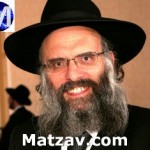
Compiled by Rabbi Yehoshua Berman
Contents:
1) Yesod Ha’Emunah is Maamad Har Sinai
2) How was it Possible for Korach Va’adaso to Become Kofrim
3) What Led the Nesiim to Join Korach
4) The Root of the Aveirah of Korach Va’adaso
5) Why Didn’t Moshe Daven for Korach Va’adaso
1 – Yesod Ha’Emunah is Maamad Har Sinai
The Rambam says in the eighth perek of Hilchos Yesodei HaTorah that the osos that Moshe Rabbeinu performed are not the basis of emunah, because someone whose emunah is based on miracles could maintain a question mark of doubt. Rather, only Maamad Har Sinai wherein we, as a nation, ourselves heard and saw the Ribbono shel Olam speaking to Moshe, is the basis of emunah, as the pasuk says, ba’avur yishmah ha’am b’dabri imach v’gam b’cha yaaminu l’olam. All the osos that Moshe did were for some particular need…when Korach va’adaso denied him, the ground opened up to swallow them.
Even the pasuk itself is a kashya on this Rambam. It says, b’zos teidun ki Hashem sh’lachani! Furthermore, after the Rambam concludes his exposition of Torah min ha’Shamayim in the yesod ha’shmini in his pirush ha’Mishnayos on perek cheilek, he brings this pasuk! B’zos teidun ki Hashem sh’lachani la’asos es kol ha’maasim ha’eileh ki lo mi’libi. This is the pasuk, says the Rambam, proves that every single os in the entire Torah is min ha’Shamayim, and that the ayin in Timnah of achos Lotan Timnah is just as kadosh b’kedushas ha’Torah as the dalet in echad of Shema Yisrael.
Lichora, what you have to say, and I later heard that they say this in the name of Rav Beryl Soloveitchik, is that Korach va’adaso caused a pikpuk of kefirah in Klal Yisrael, and the neis of the ground swallowing him up removed that pikpuk; but the foundation of emunah nevertheless exclusively remains Maamad Har Sinai.
—
2 – How was it Possible for Korach Va’adaso to Become Kofrim
The Rambam in Igeres Teiman says that v’gam b’cha yaaminu l’olam is a havtacha that anyone whose ancestors stood by Har Sinai will not become an apostate. Someone who becomes a kofer, it must be that his ancestors were not by Har Sinai. It’s clear that what the Rambam mean is that such a person is from the Eirev Rav. The Ramban says that by Maamad Har Sinai, the Eirev Rav had their own station, so effectively they were not part of it; thus, kefirah in Klal Yisrael comes from them. This is not to say that such a person is biologically descendant of the Eirev Rav. Rather, it is that the neshamos of the Eirev Rav got mixed into the pool of the neshamos of Klal Yisrael, and such a person has a neshama from the Eirev Rav.
The kashya here is blatant. Even had this happened with the great, great, great grandchildren of Korach we would have had a kashya, and Korach va’adaso were themselves there by Maamad Har Sinai! For us, this particular nekudah wouldn’t necessarily be a kashya, because even though our neshamos were by Maamad Har Sinai, it isn’t
necessarily at the forefront of our conscious memory. Maybe yes, maybe no. But Korach va’adaso most definitely had Maamad Har Sinai within the purview of their immediate recollection! In any event, they were certainly there, so how could the Rambam say that anyone whose ancestors were there it’s a garuantee that he won’t fall into kefirah? This kashya was asked to the Steipler by Rav Moshe Mordechai Shulsinger.
He writes the answer that the Steipler gave him. What the Rambam is saying is that someone whose ancestors stood by Har Sinai will not one fine morning wake up and out of nowhere become an aethiest. However, if a person becomes mired in aveiros, then that could cause him to lose his clarity of understanding, like Chazal say by maachalos asuros that it’s metamteim es ha’leiv. It doesn’t mean he for sure will become a kofer, but it could possibly lead there. Likewise, if a person doesn’t have a handle on his bad middos, it is possible that they could lead him astray to the point of kefirah. Also, if a person exposes himself to sefarim chitzoniyim or a bad environment. About all these things the havtacha was not said, and that is what happened with Korach, because he was drawn into the middah raah of kinah over the appointment of his cousin.
The havtacha was only said about someone who was never exposed to any of these things and out of nowhere he became an aethiest. Of course, there is no-one like that, so of course you cannot say about someone who is weak in emunah, “oh, he must be from the Eirev Rav”. Avadah not. The main musar haskeil to take out of here is that emunah is something that needs to be preserved, safeguarded, and worked on.
—
3 – What Led the Nesiim to Join Korach
Rashi brings that the Nesiei Eidah of adas Korach were “Elitzur ben Shdeiur v’chaveirav”. That means that these are the very same people who brought the korbanos of the Chanukas Ha’Mizbeiach of the Mishkan! What got into them?! The zechus that they had then was so great that Aharon Ha’Kohein got chalishus ha’daas from the fact that his sheivet wasn’t part of it!
The Netziv explains that b’etzem they were mevakshim kirvas Hashem, just that they were mistaken in their approach. They thought that the only way to get fully close to Hashem is through the avodah in the Mikdash, and that caused them to get in over their head. They were misguided mevakshim. Perhaps Korach was also a misguided mevakeish, to an extent.
—
4 – The Root of the Aveirah of Korach Va’adaso
The Mishna in Avos says that the machlokes of Korach va’adaso was a machlokes sheh’lo l’sheim Shamayim. Lichora this is a pliah – that was the only chisaron that they had? They were kofer in Torah min ha’Shamayim! Although it’s a mussar vort, the only pshat here is that the Mishna is not identifying the pinnacle of what they did wrong, but the root of what brought them to such terrible deeds. It was the fact that they were functioning sheh’lo l’sheim Shamayim. Korach va’adaso did not all of a sudden say that Torah is not min ha’Shamayim. It began with being upset over the nesius of his cousin Elitzafan ben Uziel and/or the claim of “kulam kedoshim”, but because their motivation was not l’sheim Shamayim – even though they may have been seeking higher madreigos in ruchniyus! – it snowballed into a downward spiral until eventually it came to the point that they were actually kofer in Torah min ha’Shamayim. It is possible that they convinced themselves that they really were functioning l’sheim Shamayim, but had they dug deeper into themselves, they would have discovered that that is not the case.
—
5 – Why Didn’t Moshe Daven for Korach Va’adaso
Rabbeinu Bachayei asks, why didn’t Moshe Rabbeinu daven for Korach va’adaso? Moshe was always a faithful shepherd, standing in the breach with his teffilos whenever Klal Yisrael got into trouble, so why was this instance different? Rabbeinu Bachayei answers – and this is something that you just have to take as a yediah – that this is not a question that can be answered b’derech pshat, but only with a mesorah: Korach va’adaso were a gilgul of the dor haflagah and anshei Sdom which is merumaz in the words, “anshei sheim”. By the dor haflagah they said “naaseh lanu sheim”, and by Sdom they are called “anshei Sdom”. It is also merumaz in the words “vayakumu lifnei Moshe” – lifnei, because this is not their first appearance; they’ve been around before and already had two chances. This third, final chance was their last, and they still resisted tikun; at this point Moshe felt that all was lost and nothing could be done for them further, and that is why he did not daven for them.
Whether we understand this or not, it is a yediah.
(Conglomerate of two audio recordings, available here: http://nermichoel.org/index/shiur/category/sefer-bamidbar/subcategory/korach/speaker/rabbi-twersky)
{Matzav.com Newscenter}











